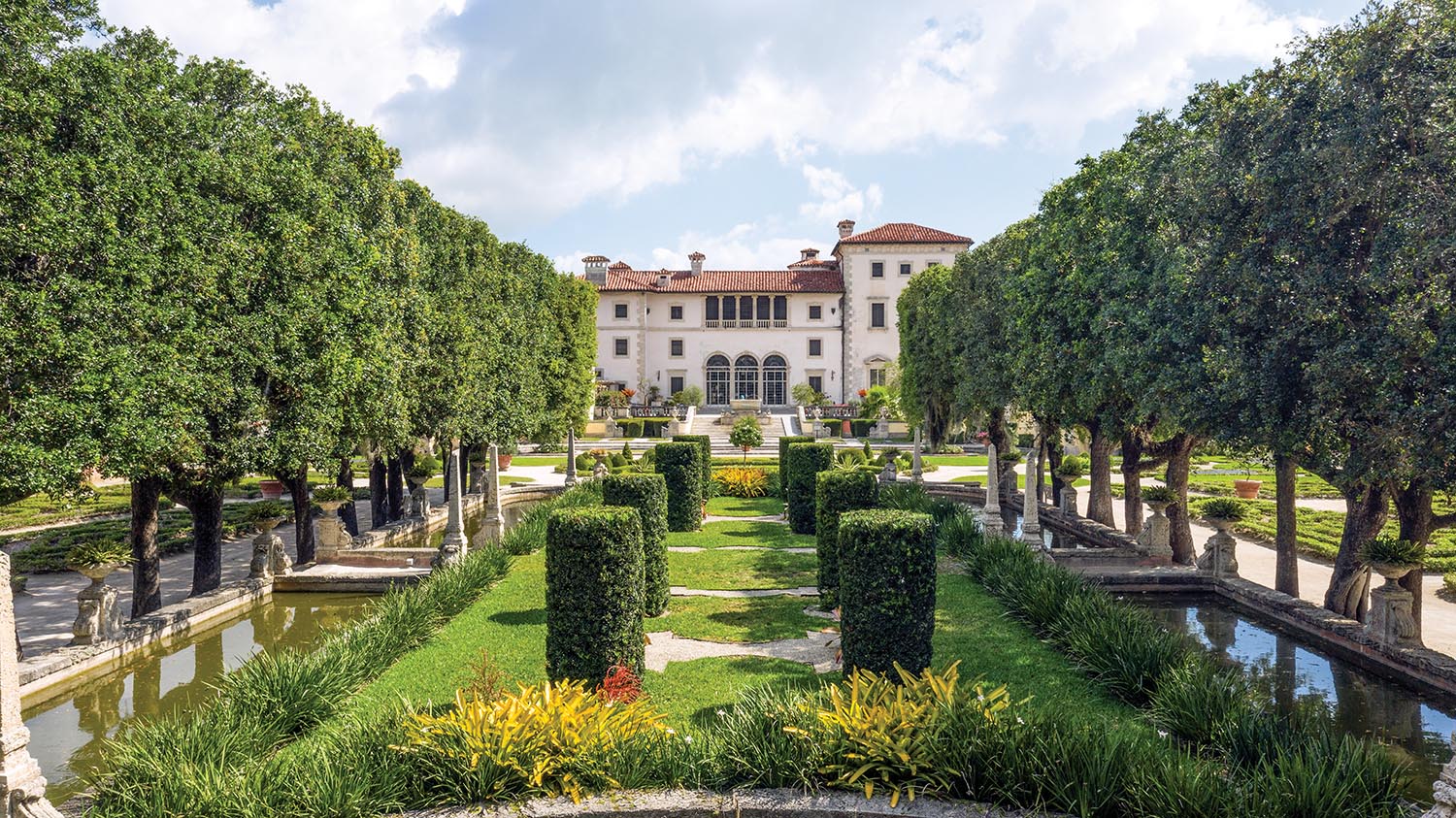
Photo by Robin Hill, courtesy of Vizcaya Museum and Gardens
The long view north from the Mound to the main house features a basin and island lined with ornaments of obelisks, scrolls, and urns framed by an allée of clipped live oaks.
Celebrated American artist John Singer Sargent wrote the following to a friend while he was visiting Vizcaya and painting a series of watercolors there in 1917: “The great big villa that James Deering has built down here is a mine of sketching. It is like a giant Venetian Villa on the Brenta with columns & loggias & porticos and ships down to the water, and dark gardens with statues just like Frascati. I can’t tear myself away.” Not only does Sargent sum up the enchantment of Vizcaya in only a few sentences, he also imparts the sentiment that the estate is easy to fall in love with because of its beauty. Even the name Vizcaya describes itself well, originating from a Basque word that translates as “an elevated place.” Its name also reflects that of a province in Northern Spain situated on the Bay of Biscay, which in Spanish translates to the Gulf of Vizcaya.

Photo by Robin Hill, courtesy of Vizcaya Museum and Gardens
The outbuilding, an open loggia called the Casino on the Mound, was built as a focal point on the main axis from the house. It served as a tea house and shelter complete with a fireplace.
A product of the wealth of the Gilded Age—a time period that also produced grand country homes such as the Biltmore, San Simeon, and the great estates of Newport, Rhode Island—Vizcaya was the vision of James Deering, who along with his father and brother created the Illinois-based Deering Harvester Company that later became International Harvester after a merger with a rival firm.
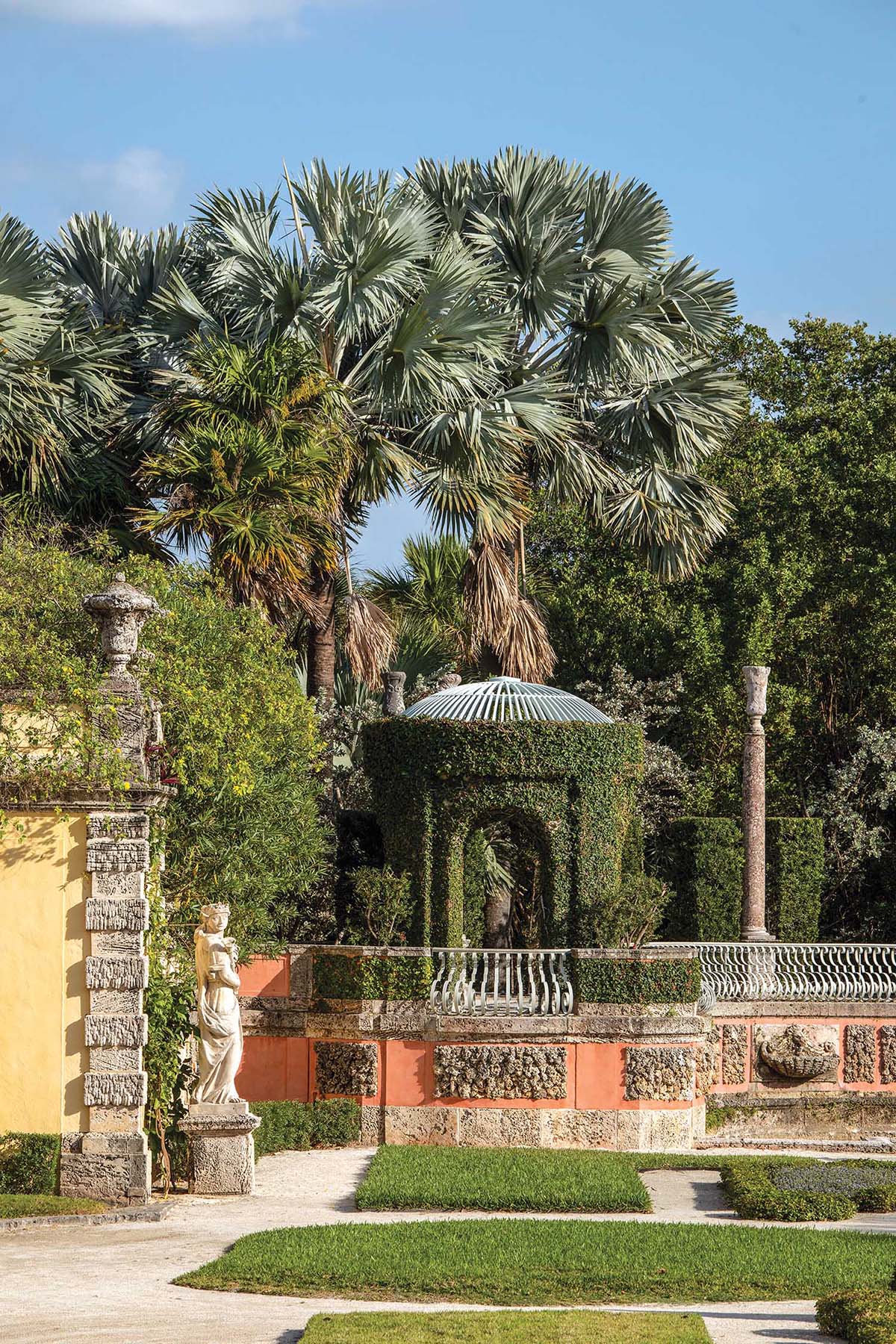
Photo by Robin Hill, courtesy of Vizcaya Museum and Gardens
The cross axis of the garden is defined by the balanced placement of semicircular pools and vine-covered dome gazebos.
Deering had a specific vision for his winter residence, and like many successful businessmen, he was used to being in charge. He was leery of hiring a famous architect who might have more of an opinion, so he took a chance on some relative neophytes: Paul Chalfin, an artist and protégé of Elsie de Wolfe (she had designed the interiors for Deering’s Chicago apartment); New York architect Francis Burrall Hoffman (recommended to Chalfin by Ethel Barrymore); and garden designer and architect Diego Suarez, who had studied at the Accademia di Belle Arti in Florence.
Deering was extremely hands-on throughout the project and engaged in every detail with the creative team. He and Chalfin travelled extensively throughout Italy to study the villas and their gardens, gathering inspiration along the way and making purchases for the proposed estate. Deering decided that the villa should be sited right on the water so as to preserve the existing ridge with its dense hardwood forest, which would have been a more practical and less expensive location. His unique direction is what ultimately distinguished Vizcaya from the crowd of storied country estates of the well-heeled. The mansions of Newport and Long Island looked out over vast stretches of lawn to the sea. However, Vizcaya’s waterside placement made the bay a part of the conversation at all times and necessitated that the gardens be located on the side of the villa, giving them a distinctive presentation in the landscape.
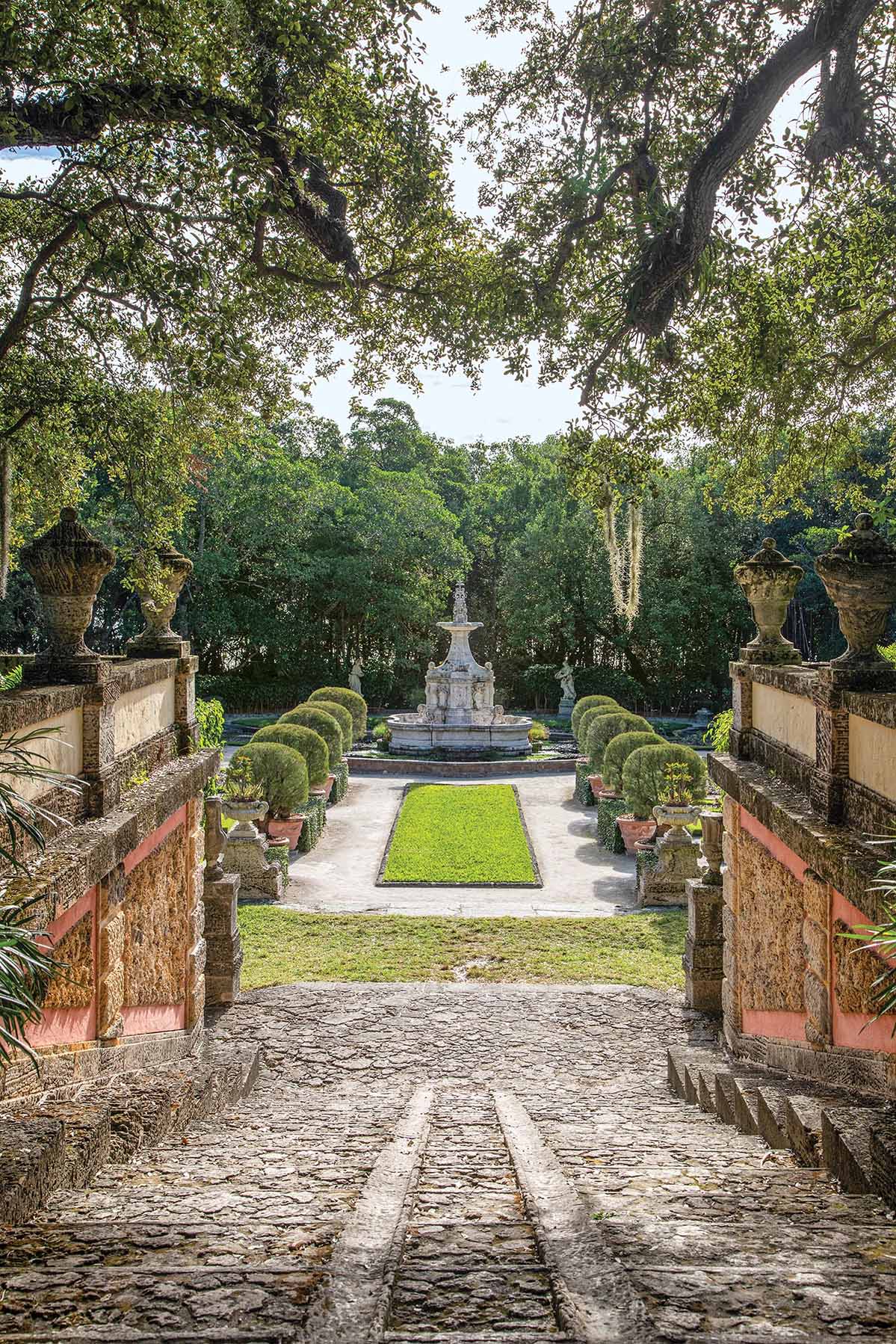
Photo by Robin Hill, courtesy of Vizcaya Museum and Gardens
A slope paved with stone leads to a central fountain surrounded by neat manicured hedges.

Photo by Robin Hill, courtesy of Vizcaya Museum and Gardens
Triumphal arches frame the arrival court and feature mythical trophies and seahorses, motifs Deering selected for Vizcaya to mimic those at the Palazzo Bevilacqua in Verona, Italy.
Suarez initially designed the grounds and gardens of Vizcaya without visiting the property, which proved to be an exercise in futility, as Ian Simpkins, Senior Director of Horticulture and Sustainability, explains. “When Suarez got to the site, he discovered a blazing sun, flat topography, and salt marshes. His original design would have reflected harsh light right into the main house.” So he redesigned the gardens, this time using European principles that involve controlling the view as well as where the eye will rest. “The constraints built into formal European garden design are meant to represent humanity’s role in reflecting nature as a lens in which you see nature perfected,” says Simpkins. “Part of what makes Vizcaya’s gardens so magical is the tension—this tightly restrained garden space in the midst of this wild forest that surrounds it.”
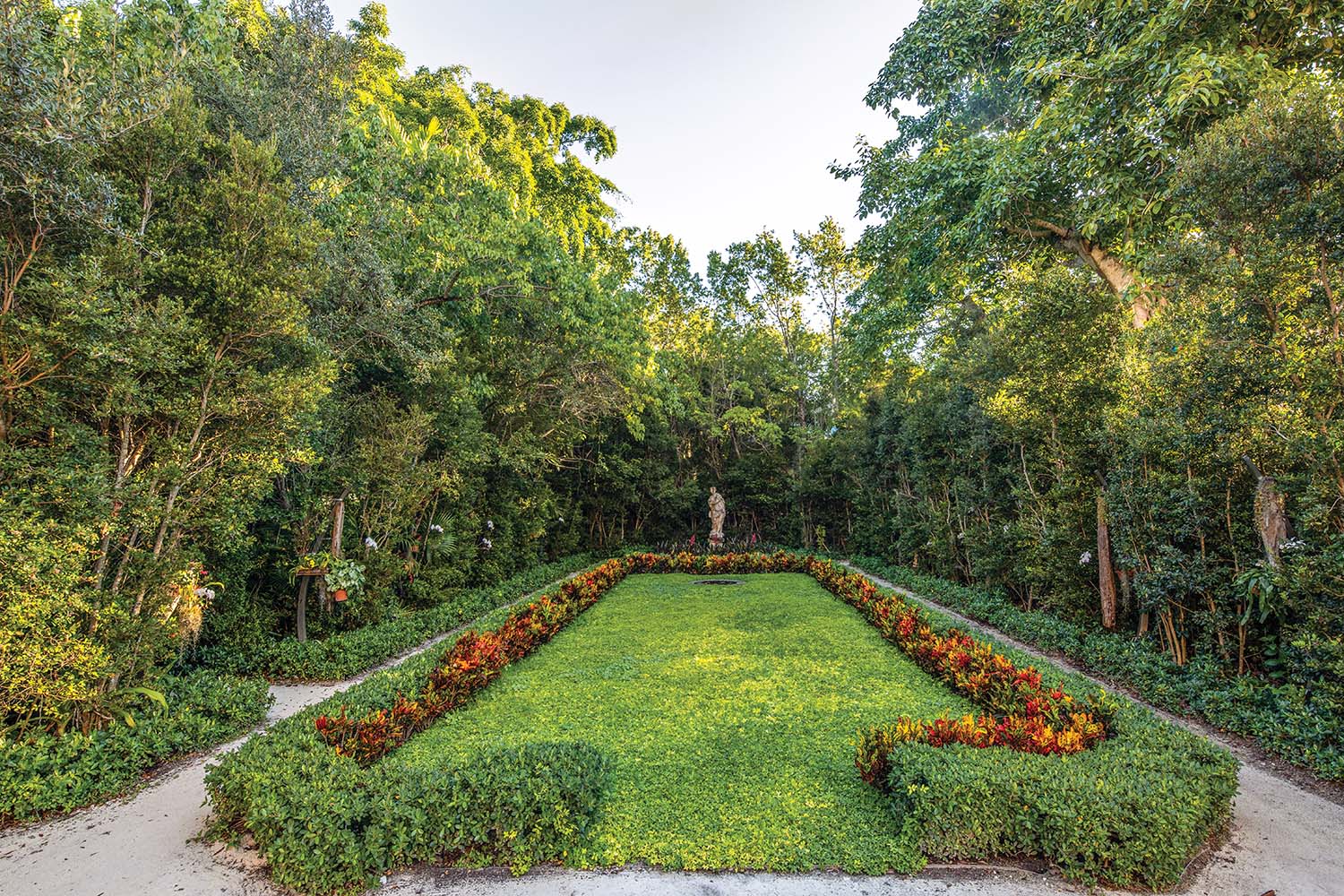
Photo by Robin Hill, courtesy of Vizcaya Museum and Gardens
With its manicured lawn and hedges, the orchidarium includes many varieties of orchids, some native to Florida.
Suarez also came up with some unique solutions to accommodate the South Florida environment. First, he created statuary-lined walks on either side of the main garden, which served both to focus the view and block the wind coming off the bay. He also took care of the flatness of the site by creating a mound in the back of the garden. “The Garden Mound served to stop your eye at the end of the garden and prevent it from going beyond,” says Simpkins. “The Casino (an indoor/outdoor pavilion) built on top also anchored your eye.” However, the Garden Mound created another problem for Suarez. In front was a large expanse of flat land that needed addressing. His solution was a high French Renaissance “goose foot” parterre design, a rather unusual choice to put into an Italianate baroque-style garden but extremely successful with its connecting axes within a symmetrical outline.
Vizcaya was created with the intention of transporting the visitor to another place and time, and every inch does just that, beginning with the tranquil green entrance drive through a now-endangered South Florida hardwood hammock forest that leaves the noise of Miami far behind. “It was brilliantly executed to immerse you and to create an experience that you not only observe but actually become a part of,” says Simpkins. “I believe that is the reason, above everything else, why people love the gardens of Vizcaya so much. When they come here, they forget about what they were doing or what they were worried about. They become part of its theater.”
CONTINUING THE LEGACY
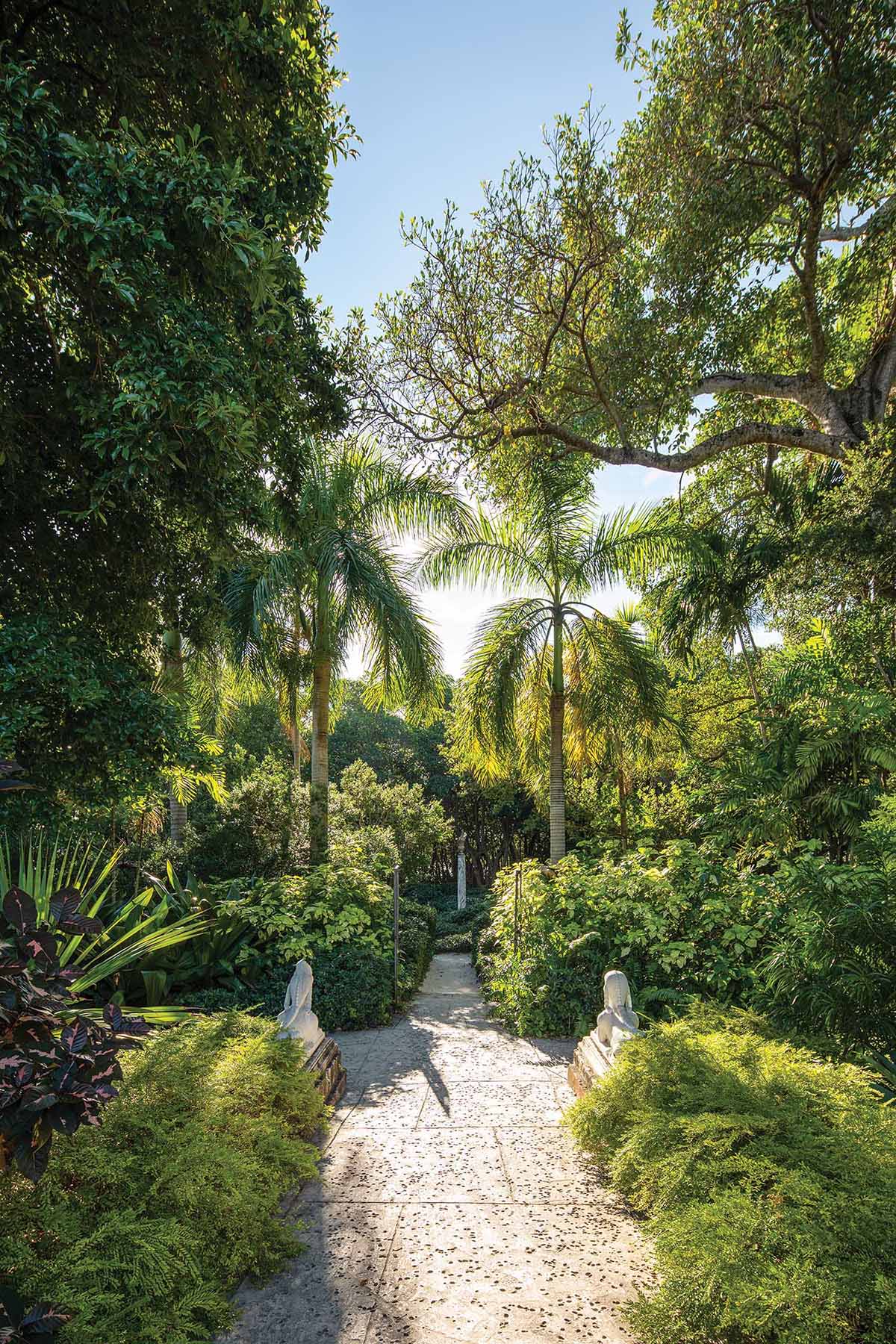
Photo by Robin Hill, courtesy of Vizcaya Museum and Gardens
Paths that lead to surprises at every turn are part of Vizcaya’s allure. The sense of discovery is transportive.
While the entire horticultural team is dedicated to preserving the gardens as they were originally realized through the lens of the vast design archives, Vizcaya is not stuck in time. “Some parts, like the rose garden, are sacrosanct. But in other parts, we have no clear design precedent,” says Ian Simpkins, Senior Director of Horticulture and Sustainability. “If the plants that were originally designed for those areas do not contribute to the visitor’s experience, we introduce rare or unusual plants, as long as they are appropriate for the space. For example, the northern parterre was destroyed in Hurricane Irma, so we took the opportunity to go back to the original design while also experimenting with different plants that could be more sustainably grown.”
According to Simpkins, the gardens will be completely restored starting in two years with the help of a firm that specializes in historic landscapes. All the original water features will be operable again, making the trills of running water present at every turn. “We plan to faithfully interpret the original design intention while looking at what we can effectively improve,” says Simpkins. “We will be updating the gardens for their 21st-century use as a public space. Vizcaya was not originally designed for 350,000 visitors a year, so there will be some modernization introduced. However, the magic of Vizcaya will always be its heart and soul.”
By Alice Welsh Doyle | Photography by Robin Hill, courtesy of Vizcaya Museum & Gardens



